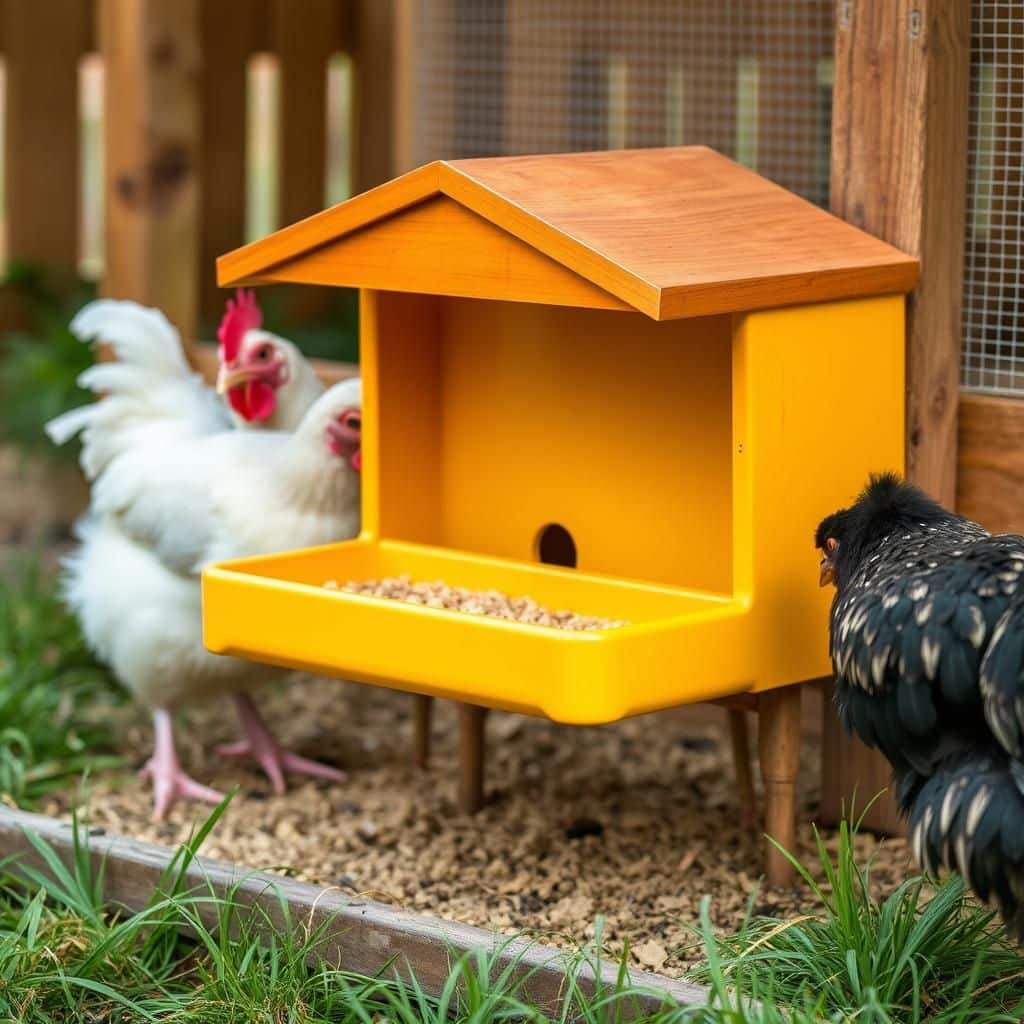Top Benefits of Using a Rodent Resistant Chicken Feeder for Your Flock

As backyard poultry farming gains popularity, ensuring the health and safety of your flock becomes increasingly important. One essential aspect of chicken care is preventing rodent infestations, which can harm both your chickens and your feed supply. Utilizing a rodent resistant chicken feeder can significantly enhance your flock's well-being while reducing waste and maintaining a cleaner environment. In this article, we will explore the top benefits of investing in a rodent resistant chicken feeder, highlighting how it can lead to a healthier, more efficient, and stress-free experience for both you and your chickens.
Understanding Rodent Resistant Chicken Feeders
Rodent resistant chicken feeders are essential tools for poultry farmers aiming to maintain a clean and healthy environment for their chickens while minimizing food wastage. These specialized feeders are designed to thwart the efforts of rodents, such as rats and mice, which are notorious for raiding traditional feeders and contaminating feed supplies. They often feature mechanisms that only allow chickens easy access to the feed, while preventing smaller animals from gaining entry. By using a rodent resistant feeder, poultry owners can ensure that their chickens receive an adequate supply of food without the risk of disease transmission that pests can introduce. Moreover, this innovation can also lead to cost savings by reducing feed loss and keeping the feeding area cleaner, promoting better overall flock health.
What Makes Feeders Rodent Resistant?
Rodent resistant feeders incorporate various design features that make it difficult for rodents to access the feed. For instance, they often have weighted lids that only open when a chicken stands on a platform, thus keeping the feed contained and protected from pest intrusions. Other designs might utilize elevated structures that place the feed out of reach of ground-based rodents. Materials used are also important; many rodent resistant feeders are constructed from durable plastics or metals that do not easily break or bend, further preventing rodents from gaining access. Effective rodent resistant feeders combine several of these factors, thus providing a reliable solution for livestock owners.
Benefits of Using Rodent Resistant Feeders
The primary benefit of using rodent resistant feeders is the protection they offer against food wastage due to pest consumption. This not only ensures that nutrients remain available for the chickens but also helps in maintaining a cleaner feeding environment. As these feeders limit rodent access, they significantly reduce the risk of disease transmission, which can be catastrophic for flocks. Additionally, maintaining feed integrity can lead to healthier birds, as they can access the necessary nutrition without contamination. Furthermore, rodent resistant feeders can contribute to cost efficiencies by minimizing the amount of feed that gets spoiled or stolen.
Types of Rodent Resistant Feeders
There are several types of rodent resistant feeders available on the market, each designed for specific poultry needs. Some popular types include hanging feeders, which are suspended off the ground to deter rodents, and self-feeding systems, which utilize gravity to keep food consistently available while minimizing spills. Additionally, there are automatic feeders, which dispense controlled amounts of feed at scheduled intervals to prevent excess food from being exposed. Each type of feeder offers varying levels of protection and can be chosen based on the specific needs of the flock and the environmental conditions in which they are raised.
See also:
Maintaining Rodent Resistant Feeders
To ensure the long-term effectiveness of rodent resistant feeders, regular maintenance is crucial. This includes routine cleaning to remove any spilled feed or waste that may attract pests. Users should inspect all feeder components for damages or wear and tear, particularly the mechanisms that allow for controlled access. Keeping the feeders in good working order and routinely checking their performance helps maintain their intended functionality. During the off-season, it's also advisable to store the feeders in a dry, secure location to prevent deterioration from weather conditions or further rodent intrusion.
Cost Considerations for Rodent Resistant Feeders
The initial investment in rodent resistant feeders can vary widely based on features, materials, and brand. While they typically cost more than traditional feeders, the potential cost savings from reduced feed wastage can justify the expense over time. Costs should also be weighed against the benefits of improved chicken health and decreased risk of disease. It's important for poultry owners to consider not only the purchase price but also the durability, functionality, and maintenance requirements when evaluating the overall value of different feeder options. Analyzing these factors can lead to a more informed decision that best suits the needs of the flock and the objectives of the farm operation.
| Feature | Description |
|---|---|
| Weighted Lid | Open only for chicken access, deterring rodents. |
| Elevated Design | Keeps feed out of reach of ground-dwelling rodents. |
| Durable Materials | Resist chewing and damage from various pests. |
| Gravity Feeding | Controlled food dispensation to minimize spills. |
| Automatic Dispensing | Provides regulated amounts of feed at set intervals. |
Enhanced Feed Security for Healthier Flock Management
The use of a rodent resistant chicken feeder significantly enhances feed security, effectively deterring unwanted rodents from accessing the food supply meant for your flock. This not only helps maintain the nutritional integrity of the feed but also reduces the likelihood of disease transmission associated with rodent infestations. A cleaner feeding environment ensures that your chickens receive nutritious food without the risk of contamination, promoting overall healthier and more productive flock management.
Reduction of Feed Waste
By using a rodent resistant feeder, you can expect a substantial reduction in feed waste. Traditional feeders often allow rodents to access leftover feed, leading to significant loss of nutrition and resources. With a properly designed rodent resistant model, the feed stays contained, ensuring that your chickens eat what they need and that any leftovers remain protected. This conservation of feed not only saves money but also promotes a more efficient feeding method for your flock.
Minimized Risk of Disease
Rodents are known carriers of various diseases that can be detrimental to poultry health. Utilizing a rodent resistant chicken feeder minimizes the risk of disease spread by preventing rodents from accessing the feed, which could otherwise become contaminated. This proactive approach to feed management significantly reduces instances of common poultry ailments, contributing to the overall well-being and productivity of your chickens.
See also:
Improved Feed Quality
One of the primary benefits of a rodent resistant feeder is the improvement in feed quality. By keeping rodents away, the feeder helps preserve the freshness and nutritional value of the feed. Rodents can introduce waste, urine, and pathogens that compromise feed quality, making it less nutritious for the chickens. An effective rodent resistant chicken feeder ensures that your flock has access to high-quality feed, essential for their growth and egg production.
Convenience and Ease of Use
Rodent resistant chicken feeders are designed with user convenience in mind. Many models incorporate features that make it easy to fill and clean while still providing security against rodents. This means that flock owners can spend less time managing feed and cleaning up waste, allowing for a more streamlined approach to poultry management. The ease of use ensures that even those new to chicken keeping can maintain a healthy and effective feeding routine.
Long-Term Cost Savings
Investing in a rodent resistant chicken feeder can lead to significant long-term cost savings. While the initial investment may be higher than traditional feeders, the reduction in feed waste, decreased likelihood of disease, and preserved feed quality can provide considerable savings over time. Flock owners will find that this equipment pays for itself through enhanced flock productivity and reduced veterinary costs, making it a smart financial decision in the long run.
Questions from Our Readers
What is a rodent resistant chicken feeder?
A rodent resistant chicken feeder is a specially designed feeding system for chickens that prevents rodents from accessing the feed. These feeders typically feature mechanisms that keep the food secure when not in use, ensuring that only chickens can eat and minimizing waste and contamination.
How does a rodent resistant chicken feeder work?
Rodent resistant chicken feeders often utilize gravity-fed or locking mechanisms that only allow chickens to access the feed. Some models include features like weight-sensitive lids that stay closed when a lighter animal tries to enter, effectively blocking rodents from stealing the feed.
See also:
Are rodent resistant chicken feeders effective?
Yes, most rodent resistant chicken feeders are highly effective in reducing rodent access to chicken feed. They are designed to be durable and efficient, significantly decreasing the chances of contamination and the presence of rodents in your chicken coop, thus promoting better health for your flock.
Can I build my own rodent resistant chicken feeder?
Absolutely, you can create a DIY rodent resistant chicken feeder using materials like PVC pipes and metal mesh. There are numerous tutorials available that guide you through the process of building a feeder that keeps feed safe from rodents while still being accessible to your chickens.

If you want to read more articles like Top Benefits of Using a Rodent Resistant Chicken Feeder for Your Flock, we recommend you check out our Gardeners category.
Leave a Reply
Related Articles